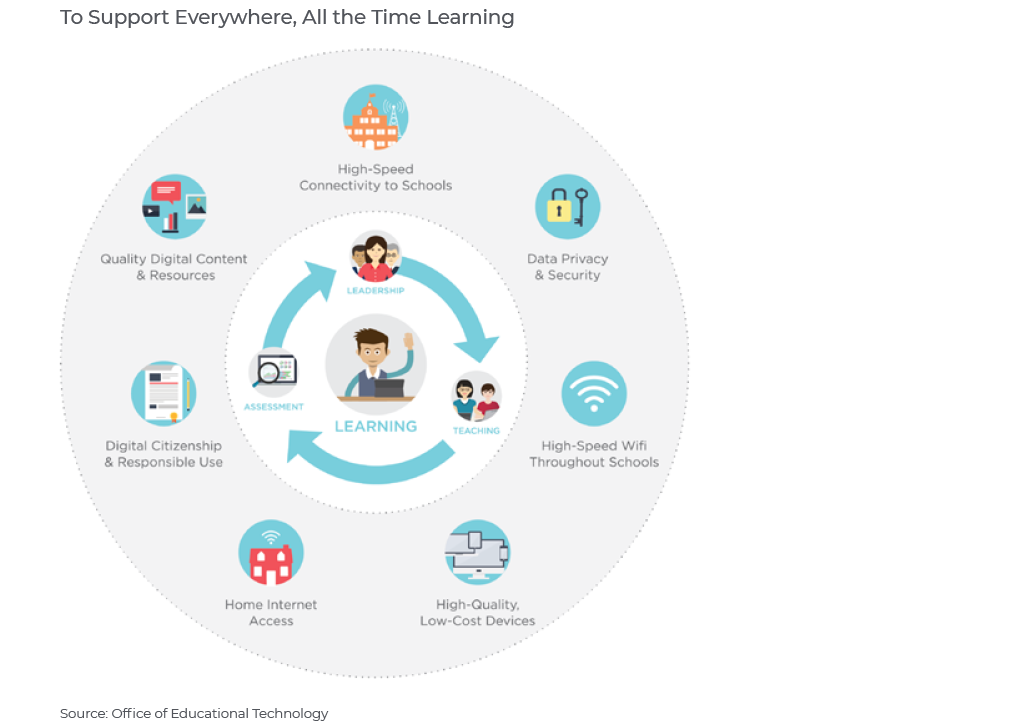How E-Rate Funding Is Enabling K-12 Schools to Expand Network Capabilities

E-Rate funding has been a boon for many K-12 educational institutions, providing badly needed resources for technology initiatives. Now is the time for primary education IT and administrative leaders to think about how to use E-Rate funding to provide advanced, high-performance networks for a range of important new use cases.
In many ways, the challenges of providing enough tools and resources for K-12 school systems aren’t very different from what they were a generation or two ago. School districts are facing increased educational and operational needs, yet funding sources remain under pressure, especially in districts with less wealth than others. Class sizes continue to increase, and the amount of information students must consume and master is exploding.
There’s a flip side to those challenges, however: school systems are benefiting from the increased availability of cutting-edge technologies to accelerate new learning initiatives in the classroom while enhancing productivity and efficiency among teachers, staff, and administrators. The Federal Communications Commission has made billions of dollars available to schools through its E-Rate technology funding program, which remains important as school systems increase their reliance on technology to help drive student achievement.
This paper looks at some use cases for K-12 educational and administrative requirements, the vital role high- performance networks play in driving those applications and what to look for in identifying high-performance networking solutions and a technology partner for your next E-Rate funding proposal.
How high-performance networks help drive digital learning and front-office efficiency
School systems have largely embraced the notion that information technology can provide dramatic enhancements in how students are taught and how school systems themselves are managed. However, K-12 organizations are looking to step up their use of technology to deliver even higher levels of functionality and productivity in the classroom and throughout their administrative operations.
Many applications are using technology to help enhance student achievement, and improve teacher and school district workforce productivity. Those applications include:
Personalized teaching and curriculum delivery. Technology can allow teachers to construct and deliver one-on-one education for individual students’ unique needs, adapting digital content to different requirements.
Active learning technology. Students are increasingly interacting and engaging with digital material over Wi-Fi and WAN technologies.
Distance learning and videoconferencing. Learning no longer takes place only in a single physical classroom. These applications allow students, teachers, and outside resources to collaborate over wide distances.
Internet-based services. The Internet has emerged as an invaluable education resource for everything from student research to real-time connectivity between parents and teachers.
STEM (science, technology, engineering and mathematics) support. Tools like digital microscopes, interactive laboratories and access to public research databases can help students improve achievement in critical STEM fields.
Mobility. Students, teachers, and administrators commonly use notebooks, tablets, and smartphones at any location in their non-school activities, so why should it be any different in their schools? Enhanced performance for Wi-Fi networks now make mobility a fact of life for the K-12 experience.
IoT. “Connected things” such as sensors monitoring heating and cooling system performance are being used throughout schools, requiring networking performance to handle connectivity of extremely large data sets.
Cybersecurity. Student records, financial data and other proprietary data are ripe for the picking among cyberthieves, making cybersecurity tools and security among the high priorities for school systems.
There is little debate that high-performance networking is needed to handle the bandwidth, security, intelligence, and manageability to support them. An advanced networking infrastructure and solutions are essential to meet the needs of students, teachers and staff.
Below is a great illustration of the relationships among networking technology, applications, and stakeholder groups and why networking can be an important catalyst in helping to deliver high levels of productivity.
Infrastructure

Why K-12 organizations should consider Comcast Business
With high-performance networking playing such a central role in the delivery of invaluable services for K-12 school systems, it makes sense to select a technology partner with both a wide range of networking solutions.
Comcast Business offers K-12 school systems a number of innovative networking options that can be included in E-Rate funding proposals. These include:
Ethernet solutions. Comcast Business offers Ethernet Dedicated Internet with high-speed connectivity and fiber-based dedicated Internet access. Matching upload and download speeds are available, and its high-performance bandwidth of up to 100 Gbps is ideal for data- intensive applications such as cloud storage, web conferencing and audio streaming.
Internet solutions. Comcast Business brings Internet functionality to K-12 systems, including speeds ranging from 50 Mbps to 1.25 Gbps and 24/7 dedicated business support.
Managed routers. For performance-intensive workloads that are increasingly part of K-12 school systems’ application portfolios, Comcast Business offers router management tools that cover the full spectrum of functionality, from initial configuration and installation to ongoing management and support, providing an end-to-end on-premise-based solution.
SD-WAN solutions. Software-defined infrastructure has become invaluable to organizations, and K-12 school systems can take advantage of Comcast Business’ SD-WAN offerings to provide high performance, scalability and easy deployment. Comcast Business’ SD-WAN enables distributed K-12 school districts to deliver high-speed networking seamlessly and affordably across a wide geographic area.
Managed WiFi. Mobility is a key driver for students, staff and administrators across a wide range of applications, making Wi-Fi management essential. Comcast Business Managed WiFi is ideal for the deployment and ongoing operation of Wi-Fi-enabled functions and systems, including bandwidth allocation.
Comcast Business also offers additional technology solutions—voice, video and cybersecurity solutions, for instance—that are not currently eligible for E-Rate funding but can be purchased outside of the E-Rate process. To learn more visit: https://business.comcast.com/enterprise/industry-solutions/education
For details on the E-rate program, visit the USAC website at www.usac.org/sl or call the Schools & Libraries help desk at 888.203.8100.
The E-Rate program is helping K-12 schools bolster their networks and support digital learning.
Locked Content
Click on the button below to get access
Unlock NowOr sign in to access all content on Comcast Business Community
Resource Center
Learn how Comcast Business can help
keep you ready for what's next.











